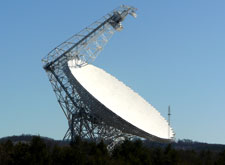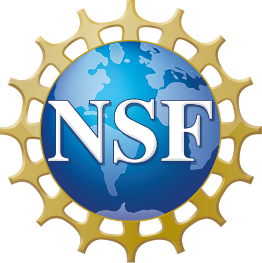Science and Software Jobs with the Green Bank Telescope
Assistant Scientist, Green Bank
The Robert C. Byrd Green Bank Telescope (GBT) is the world's largest fully steerable telescope. Working at wavelengths ranging from 100cm through 3mm, the GBT supports a diverse range of scientific research. Additionally, the GBT has a dynamic program of research and development which keeps the telescope at the cutting edge of science and technology.
The National Radio Astronomy is looking for an energetic person to join the scientific staff in Green Bank. The successful applicant will join the team of scientists at the Green Bank telescope to provide full scientific support to the GBT and the NRAO. Responsibilities of the successful applicant will include supporting observers who use the telescope as well as working on a diverse variety of projects, which may include the development and commissioning of new instrumentation on the telescope, working with the engineering staff to improve the overall telescope performance, and aiding with the data reduction pipelines needed for the GBT.
The successful candidate will have 25% of their time available for independent research. Support for research and travel are provided, as well as vacation accrual, health insurance, and a moving allowance. Position will be filled at the assistant, associate, or scientist level, depending on experience.
Minimum Education: Ph.D. in astronomy, physics or a related field required. Preferred Education: Minimum Experience: The successful applicant must have strong knowledge of radio and/or millimeter astronomy and two to three years experience.
To apply please go to https://careers.nrao.edu/ (Scientist Position) or send your CV to Shirley Curry (scurry@nrao.edu).
Software Engineer II, Green Bank:
The Robert C. Byrd Green Bank Telescope (GBT) is the world's largest fully steerable telescope. Working at wavelengths ranging from 100cm through 3mm, the GBT supports a diverse range of scientific research. Additionally, the GBT has an ongoing program of research and development projects which keeps the telescope at the cutting edge of science and technology.
The position is located at the NRAO at Green Bank, WV, an observatory which combines an academic setting with a rural environment. The successful candidate will join a team of professionals engaged in research and development in the fields of science, engineering, software development, and education. Job Duties Summary: The site is seeking a Software Engineer whose initial duties will be to help design, develop, implement, and support the Dynamic Scheduling System which is broken into three major components: a web application built with the Django web development framework, a series of custom user interfaces built with the Google Web Toolkit, and the core scheduler implemented in the functional programming language, Haskell.
The software development team for the Dynamic Scheduling project uses agile software development methods and automated unit testing to provide a working system for our sponsors at every step of system development. Upon completion of the Dynamic Scheduling project, the successful candidate will be reassigned to another of the GBT's ongoing research and development projects.
Education: A minimum of a B.S. degree in astronomy, physics, computer science, or related field is required. Advanced education or other acquired background in radio astronomy, physics, astronomical data reduction, or spectroscopy is desirable.
Experience: Four or more years of experience in the design and implementation of software in a structured environment is required, with exposure to all aspects of the software development life cycle. Experience with object-oriented programming languages, especially Python and Java is required as is experience with web development. A working knowledge of web development frameworks and tools, especially Django and Ext GWT, is highly desirable as is knowledge of a functional programming language, especially Haskell.
To apply please go to https://careers.nrao.edu/ (Staff Position) or send your CV to Shirley Curry (scurry@nrao.edu).
The Robert C. Byrd Green Bank Telescope (GBT) is the world's largest fully steerable telescope. Working at wavelengths ranging from 100cm through 3mm, the GBT supports a diverse range of scientific research. Additionally, the GBT has an ongoing program of research and development projects which keeps the telescope at the cutting edge of science and technology.
The Software Development Division at the Robert C. Byrd Green Bank Telescope (GBT) is seeking a Software Engineer to provide support for the scientists who use the GBT. This work will likely be directed initially toward improvements in the post-observing data analysis and reduction software as well as developing data reduction and analysis software infrastructure for existing instrumentation.
The position is located at the NRAO at Green Bank, WV, an observatory which combines an academic setting with a rural environment. The successful candidate will join a team of professionals engaged in research and development in the fields of science, engineering, software development, and education.
Education: A minimum of a B.S. degree in astronomy, physics, computer science, or related field is required. Advanced education or other acquired background in radio astronomy, physics, astronomical data reduction, or spectroscopy is desirable.
Experience: One to two years experience in the development of software applications. Familiariaty with standard software engineering concepts, practices and procedures is necessary. Experience in IDL, object-oriented programming, and/or Python is desirable.
To apply please go to https://careers.nrao.edu/ (Staff Position) or send your CV to Shirley Curry (scurry@nrao.edu).



